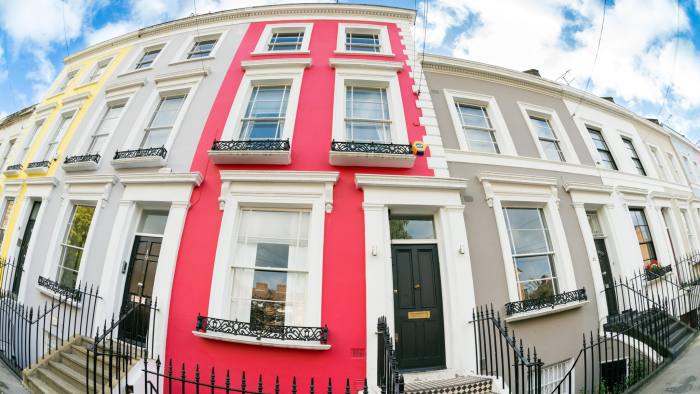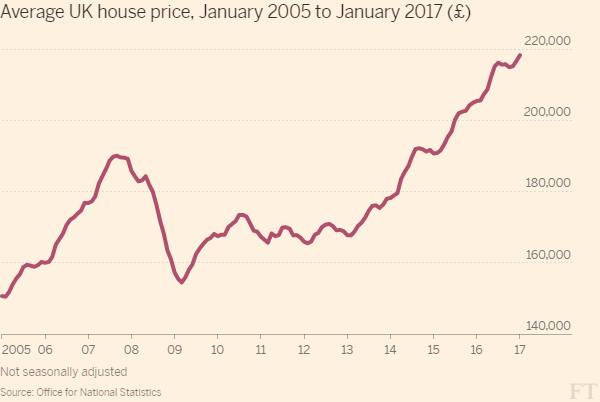London property market ‘will resist price crash’
03-21-2017
Slowdown has taken place in ‘hollowed out’ expensive central markets
© Alamy
by: James Pickford
London has been cushioned from the prospects of a house price crash by the high levels of equity required to buy property in the capital and the difficulty of mortgage financing at high loan-to-value ratios for all but the biggest earners.
Research by Hometrack, a housing market research group, found the average loan-to-value ratio (LTV) in the most expensive tenth of properties was 23 per cent and 40 per cent in mid-priced zones, compared with a UK average of 53 per cent. As well as demonstrating the high proportion of cash-rich buyers in central London, the lower loan-to-value ratios suggested the impact of a future price fall would be muted, said Richard Donnell, Hometrack research director. “The introduction of affordability testing and a maximum income multiple mean that it is hard to borrow at higher LTVs without a high income.”House prices in the capital grew at annual rate of 7.3 per cent in the year to January, compared with 6.2 per cent for the UK, according to figures published on Tuesday by the Office for National Statistics. The average house price in London was £491,000 in January, versus £218,000 across the country. However, since the Bank of England limited to 15 per cent by value of a lender’s mortgage book the number of new loans it could issue at more than 4.5 times a borrower’s income, the opportunity for large LTV mortgages in the capital has dwindled. “There is a concern that there is a bubble in the London housing market, but I don’t think that’s going to happen,” said Mr Donnell.
The research also looked at how values had changed since 2009 across 10 price bands ranked by price per square foot. Over the period, all markets saw roughly the same level of capital growth but there was large variance in the timing of rises. The top three-tenths saw fast growth in the period to 2012, as equity-rich overseas and domestic buyers bid up the price of residential homes in high value central areas. In 2013, though, growth in outer suburbs began to pick up pace, as the economy improved and mortgage rates fell. In 2009-12, prices in the most expensive tenth of the market grew by 52 per cent against 8 per cent in the bottom tenth. But in 2013-16, mid-market prices grew by only 22 per cent against a blistering 64 per cent in the cheapest tenth. Henry Pryor, a buying agent, said that in his view most of the slowdown had taken place in the “hollowed out” expensive inner London markets, while prices and transaction levels had held up in the outer zones. “It’s the Krispy Kreme effect. There’s nothing of any interest or excitement in the centre. Only around zones 2 and 3 do you start to get any enthusiasm.”Related article
UK house prices grow slower than expected
UK housing market rose by less than expected in the year to January, gaining 6.2 per cent against predictions of a 6.4 per cent rise
“Some markets have rocketed off a low base because they’ve effectively become repriced,” Mr Donnell said. “Walthamstow and Peckham have grown by more than 100 per cent in the past eight years, largely because of transport improvements and that ‘value for money’ appeal pushing further out.” Transaction levels in London have fallen by 35 per cent in the year to November 2016, according to the latest Land Registry figures, compared to a drop of 21 per cent in England. The pressure on prices in the top tenth of the market has been growing over the shorter term, with falls of 5.1 per cent in the past year. Hometrack expects further “single-digit price falls” over the course of this year at the top end. However in the middle and lower value markets, where prices are less volatile, it predicts “broadly flat” prices over the year.Mark Pattanshetti, mortgage manager at broker Largemortgageloans.com, said the top end of the market had “paused” after the Brexit vote but was likely to recover. “There isn’t enough supply in London, demand is still there and the top end is not so sensitive to interest rate changes.” Nonetheless he said banks had reined in their lending on luxury new-build apartments in the capital — a favourite vehicle for Asian investors — after fears that this part of the market had become overheated. Average loan-to-value ratios on such flats had fallen from 70 per cent to 50-60 per cent in the past three years, he said.
Copyright
The Financial Times Limited 2017. All rights reserved. You may share using our article tools. Please don't cut articles from FT.com and redistribute by email or post to the web.



